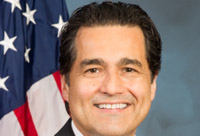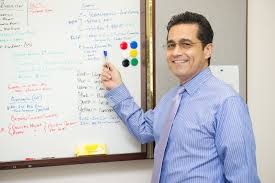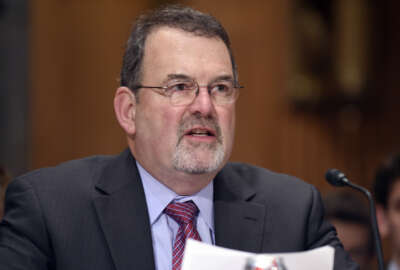
HUD takes control of IT from program offices
Rafael Diaz, the chief information officer of the Department of Housing and Urban Development, said by enforcing standards and a portfolio management approach, he...
The Department of Housing and Urban Development is correcting years of technology neglect. In the past, the program offices throughout the agency had little regard for technology architectures or standards, and shadow IT was running rampant.
But over the last two years, Rafael Diaz, HUD’s chief information officer, has turned up the HEAT—the HUD Enterprise Architecture Transformation initiative. Diaz said HEAT is changing the agency’s IT environment.

“SharePoint is going out to the cloud. All our storage is going out to the cloud. Skype for Business will be part of that capability. We will now be able to get off the high conference call bills that we have. Everything is now cloud,” Diaz said on Ask the CIO. “What we were able to do now is move some of our application development capabilities out onto the cloud. We’ve implemented Gartner’s dual modal operational capability where we have our legacy systems but we decided we are not going to build anything new on the legacy systems. We will build everything new in our cloud environment, the [Microsoft’s] Azure cloud.”
Diaz said one of the first cloud projects was implementing a customer relationship management capability for the single family home ownership center, which takes in more than 150,000 calls a year. He said HUD plans to continue to upgrade mission tools in the cloud, such as those for the Fair Housing and Equal Opportunity office.
By the end of the year, Diaz said he expects all of HUD’s email, collaboration and email storage to be in the cloud.
“We have significantly reduced our data center footprint based on that movement to the cloud. That is the other piece of HEAT. We have commissioned with NASA and we are moving into their shared services data center in Stennis, Mississippi. We are moving our data center there by the end of the year,” said Diaz, who joined as HUD’s CIO in 2014.
Additionally, he said HUD will be off the legacy HITS contracts—a $1 billion award made in 2005 to Lockheed Martin and Hewlett-Packard to run its infrastructure under a managed services contract—by the end of fiscal 2016.
“In two years, we are completely off those HITS contracts and on to a whole new set of contracts that are providing innovation for HUD, and providing a whole new level of capabilities for HUD,” he said. “We looked at what existing contracts are already out there that we can leverage? How are the current contracts set up and how can we break those out in their CLINS and where can we move that capability or that service and keep this service going without a lengthy process and within the procurement rules? We went to GSA and other agencies that have many, many contract vehicles that are available to be used and that’s what we did. We also looked at what contracts did we have that we could leverage to move forward with the breaking up of the HITS contracts. They were these mega-contracts that didn’t give us the insight into the operations that we needed. Now we have more contracts, but we have more visibility into the operational costs of those services. So now it will give us a better opportunity to understand how can we reduce those costs? How can we rationalize those costs?”
Diaz said by reducing costs, HUD can use its budget for innovative tools and technologies to better serve its customers. He said while HUD still is figuring out how much money they will save from data center consolidation and moving collaboration tools to the cloud, but as one example, the agency saved about $400,000 by consolidating and improving the management of its mobile devices and services.
Along with the cloud, Diaz has been focused on improving visibility into its network operations and end user support.
“All of this is commodity IT so we are looking at how do we implement world-class commodity IT with the contract services so that we can focus our fed resources and fed staff onto the mission IT?” he said. “We are refocusing purposing those folks, retraining those folks and giving them the skillsets to understand the mission or business of HUD.”
The move to HEAT also is part of how Diaz is modernizing HUD’s technology infrastructure. Currently, HUD spends more than 86 percent of its $342 million IT budget on old technology. And HUD’s IT request for fiscal 2017 is 16 percent lower at $288 million so finding savings for innovation is important.
Another tool HUD is using to address schedule, cost and performance challenge is a new portfolio management process. Diaz said the goal is to get better information and give a one place view for project managers, budget managers and others to see what’s happening across the entire portfolio.
“It helped us to get a better sense of the requirements at HUD,” he said.. “What was going on previously, a program office would come up with an IT requirement, they would throw the request over the fence and the CIO’s office would give them the money and they’d go off and build it. There was really no sense across HUD what the portfolio was. The CIO had no way or central point of saying, ‘here is the portfolio. Here’s what it looks like. Here’s what it’s costing us. Here’s how it’s being managed. Here’s how it’s furthering the mission. And are there any shared services capabilities that we can leverage in the portfolio?’ It really wasn’t giving us that full view and now we have that.”
He said the goal is for the mission folks to talk about capability needs and outcomes and not technology.
“They enter that into our portfolio management tool and it gives us a way to now rank all of these requests based on a rating system. We’ve worked with the deputy secretary and the customer care committee, which is one of the governance bodies made up of the general deputy assistant secretaries, to come up with a criteria for how we will rank and rate these requests to prioritize for funding,” Diaz said. “It’s allowed us to get better control over all of these projects.”
Diaz said now that the portfolio is well organized, his office can begin to rationalize and consolidate its applications as part of an overall IT modernization initiative.
Copyright © 2025 Federal News Network. All rights reserved. This website is not intended for users located within the European Economic Area.
Jason Miller is executive editor of Federal News Network and directs news coverage on the people, policy and programs of the federal government.
Follow @jmillerWFED
Related Stories





